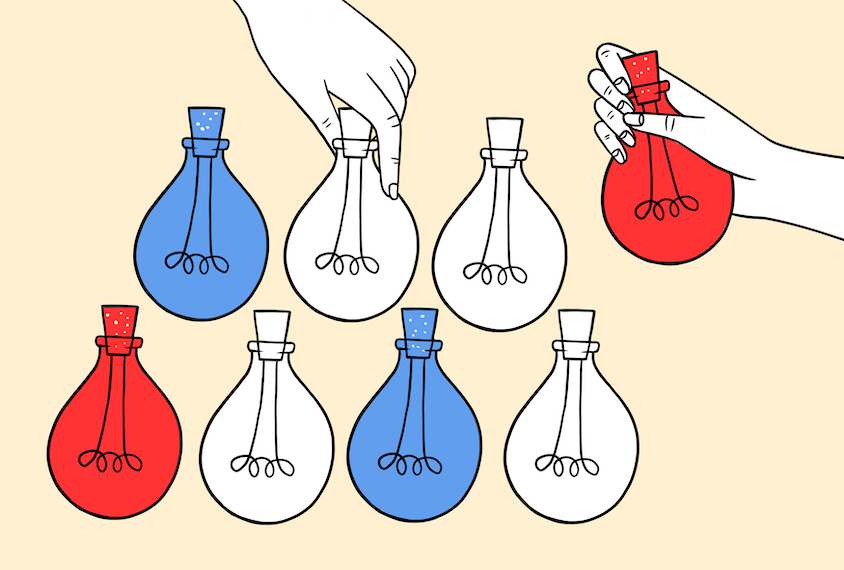The first “study to show x” is just as praiseworthy as the 10th, according to a tweet posted in September by Sarah-Jayne Blakemore, professor of psychology at the University of Cambridge in the United Kingdom. “Maybe it’s time to reduce the importance of novelty in science,” she suggested to her audience of more than 50,000 followers.
Null results merit attention, too, says Charlotte Dennison, a postdoctoral researcher at Cardiff University in Wales, who proudly presented her poster — “Polygenic risk scores are not useful when predicting recurrences of emotional disorders in young people” — at the annual World Congress of Psychiatric Genetics meeting last month.
At Spectrum, we round up replications and null results in autism research for this newsletter each month. Feel like you just read something for the 10th time? Or have you come across an interesting null finding? Drop us an email at [email protected]. Thanks for reading.
Matter of medication:
The findings are mixed when it comes to a link between antidepressant use during pregnancy and autism in children, and the association is small in the studies that find one.
Mounting results refute that link altogether, including ones published in October that took potentially confounding genetic and environmental factors into account: The children of 145,702 people who used antidepressants during pregnancy showed no increased chance of having a neurodevelopmental condition, including autism, compared with the children of 3,032,745 people who did not use the medications.
In crude analyses of the same data that did not account for any confounders, children born to a parent who used antidepressants did show an increased chance of having neurodevelopmental conditions, suggesting the association is driven by factors tied to antidepressant use and not by the medication itself.
The results were published in JAMA Internal Medicine.
No difference with dose:
Oxytocin has long drawn interest in the autism field for its potential to boost social interaction and reduce anxiety amongst autistic people. Results so far, though, have been mixed. And most research to date has focused on how oxytocin affects autistic people’s performance on particular tasks.
Last month, researchers expanded on those results by looking at oxytocin’s ability to influence intrinsic brain activity. Participants treated with oxytocin experienced reduced activity in the amygdala compared with those who got a placebo. That modulation was also associated with diminished feelings of tension, according to the study of 38 men with autism.
Previous findings supported the potential for long-term oxytocin treatment; in the new work, however, the direction and degree of change was no different in participants treated with a single dose of oxytocin compared with those who received one dose a day for four weeks.
The results were published in Translational Psychiatry in September.
Same synchrony:
One reason autistic and non-autistic people may experience the world differently is because they perceive an alignment between sights and sounds differently: Autistic people seem to have a larger ‘binding window’ — the amount of time separating audio and visual information that a person perceives to occur simultaneously, according to earlier studies.
New research questions that difference. Autistic adults and their non-autistic peers exhibited similar binding windows, and their perception adapted equally fast to asynchronous and synchronous audio-visual information. Unlike previous studies that focused on children, this one looked at people aged 18 to 56 years. The binding process changes with age, which could explain why there was no difference between autistic and non-autistic adults, the investigators write.
The findings were published in September in Autism.
Et. al.:
- Past studies have linked maternal infection to autism in children, but that relationship might not be causal, according to a new study. The association between infection and neurological outcomes was diminished when the researchers took genetic and environmental factors into account, suggesting these factors play an important role in mediating the link. The Lancet Psychiatry
- A previous edition of this newsletter reported on a study that showed no difference between autistic and neurotypical people on the “Reading the Mind in the Eyes” test. In September, another study failed to explain the test responses, reinforcing doubt around the assessment’s ability to reliably measure theory of mind. Assessment
- Anxiety often accompanies autism, with estimates suggesting that anywhere from 11 to 84 percent of autistic people also have anxiety. Cognitive behavioral therapy (CBT) — and the autism-specific version, Behavioral Interventions for Anxiety in Children with Autism (BIACA) — seem to help autistic children cope, according to a new study, but only when measured via caregiver reports. Based on reports from autistic children themselves, there was no difference between CBT, BIACA or treatment as usual. Journal of Autism and Developmental Disorders
- The Autism Diagnostic Observation Schedule, Second Edition (ADOS-2) has earned recognition as a ‘gold standard test’ in diagnosing autism. In September, researchers verified that a classification of autism using the ADOS-2 aligns with clinicians’ judgements, and that the ADOS-2’s cutoff scores fall within the range for an autism diagnosis. Autism Research
- The microbiome’s potential role in autistic people’s behavioral traits and gastrointestinal symptoms has captured researchers’ attention. New findings suggest that microbiome differences between autistic and neurotypical people are linked with behavioral traits but not with stomach problems. Brain, Behavior, and Immunity






